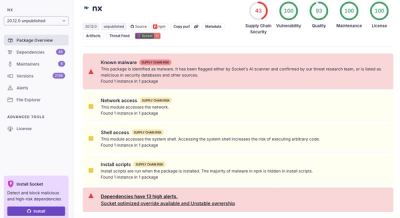
Security News
/Research
Wallet-Draining npm Package Impersonates Nodemailer to Hijack Crypto Transactions
Malicious npm package impersonates Nodemailer and drains wallets by hijacking crypto transactions across multiple blockchains.
@karmaniverous/controlled-proxy
Advanced tools
Control & modify the behavior of any object non-destructively at runtime.

controlledProxy allows the behavior of any object to be modified & controlled non-destructively at runtime.
The developer can:
Alter the proxy's endpoint controls at runtime.
Specify a context-aware handler for disabled endpoints, also at runtime.
Create multiple proxies of an underlying object, each controlled differently.
Inject proxies into dependent code & control them from the outside.
Easy use case:
You have a utility library with extensive logging.
You consume that library from an application that uses a custom logger like winston.
You want your utility library also to log to winston.
You normally want debug logging from the utility library disabled, even when it is enabed in the outer application, but you want to enable it selectively to help debug the outer app.
npm install @karmaniverous/controlled-proxy
The controlledProxy function creates a type-safe proxy of any object.
The options parameter is an object with the following properties:
| Property | Type | Default | Description |
|---|---|---|---|
defaultControls | Record<PropertyKey, boolean> | {} | A map of controlled property keys to boolean values. When this value is true or the property is uncontrolled, the property will behave normally. When this value is false, the property will execute the disabled member handler or return undefined. |
defaultDisabledMemberHandler | DisabledMemberHandler | () => undefined | A function that is called when a disabled controlled property is accessed. |
target | object | required | The object to proxy. |
import { controlledProxy } from '@karmaniverous/controlled-proxy';
// Create a controlled console logger. Info messages are disabled by default.
const controlledConsoleLogger = controlledProxy({
defaultControls: { debug: true, info: false },
target: console,
});
// Log messages.
controlledConsoleLogger.debug('debug log');
controlledConsoleLogger.info('info log');
// > debug log
The proxy object has two special properties, keyed with symbols that can be imported from the package:
| Property | Type | Description |
|---|---|---|
[controlProp] | Record<PropertyKey, boolean> | A map of controlled property keys to boolean values. When this value is true or the property is uncontrolled, the property will behave normally. When this value is false, the property will execute the disabled member handler or return undefined. |
[disabledMemberHandlerProp] | DisabledMemberHandler | A function that is called when a disabled controlled property is accessed. Defaults to () => undefined. |
import {
controlledProxy,
controlProp,
disabledMemberHandlerProp,
} from '@karmaniverous/controlled-proxy';
// Create a controlled console logger. Info messages are disabled by default.
const controlledConsoleLogger = controlledProxy({
defaultControls: { debug: true, info: false },
target: console,
});
// Disable debug messages & enable info messages at runtime.
controlledConsoleLogger[controlProp].debug = false;
controlledConsoleLogger[controlProp].info = true;
// Log messages.
controlledConsoleLogger.debug('debug log');
controlledConsoleLogger.info('info log');
// > info log
// Change the disabled member handler.
controlledConsoleLogger[disabledMemberHandlerProp] = (
target: Console,
prop: PropertyKey,
) => target.log(`Accessed disabled member: ${prop.toString()}`);
// Log messages again.
controlledConsoleLogger.debug('debug log');
controlledConsoleLogger.info('info log');
// > Accessed disabled member: debug
// > info log
Here's an example of the real power of the library: let's inject a controlled proxy into a class!
import { controlledProxy, controlProp } from '@karmaniverous/controlled-proxy';
// Create a class that accepts a proxied logger as a constructor argument.
class MyClass {
// Proxied logger must be compatible with console.debug & console.info.
constructor(private logger: Pick<Console, 'debug' | 'info'>) {}
// Exercise the proxied logger.
myMethod() {
this.logger.debug('debug log');
this.logger.info('info log');
}
}
// Create a controlled console logger, with all messages enabled by default
// and a custom disabled member handler.
const controlledConsoleLogger = controlledProxy({
defaultControls: { debug: false, info: true },
defaultDisabledMemberHandler: (target: Console, prop: PropertyKey) =>
target.log(`Accessed disabled member: ${prop.toString()}`),
target: console,
});
// Instantiate the class with the controlled console logger.
const myConsoleInstance = new MyClass(controlledConsoleLogger);
// Disable console debug messages at runtime.
controlledConsoleLogger[controlProp].debug = false;
// Exercise the proxied console logger from within the class.
myConsoleInstance.myMethod();
// > Accessed disabled member: debug
// > info log
// Create an equivalent controlled winston logger, with all messages enabled by
// default and a custom disabled member handler.
import { createLogger, type Logger } from 'winston';
const controlledWinstonLogger = controlledProxy({
defaultControls: { debug: true, info: true },
defaultDisabledMemberHandler: (target: Logger, prop: PropertyKey) =>
target.log('warn', `Accessed disabled member: ${prop.toString()}`),
target: createLogger(),
});
// Instantiate the class again with the controlled winston logger.
const myWinstonInstance = new MyClass(controlledWinstonLogger);
// Disable winston debug messages at runtime.
controlledWinstonLogger[controlProp].debug = false;
// Exercise the proxied winston logger from within the class.
myWinstonInstance.myMethod();
// > [winston] { "level":"warn", "message":"Accessed disabled member: debug" }
// > [winston] { "level":"info", "message":"info log" }
Built for you with ❤️ on Bali! Find more great tools & templates on my GitHub Profile.
FAQs
Control & modify the behavior of any object non-destructively at runtime.
We found that @karmaniverous/controlled-proxy demonstrated a healthy version release cadence and project activity because the last version was released less than a year ago. It has 1 open source maintainer collaborating on the project.
Did you know?

Socket for GitHub automatically highlights issues in each pull request and monitors the health of all your open source dependencies. Discover the contents of your packages and block harmful activity before you install or update your dependencies.

Security News
/Research
Malicious npm package impersonates Nodemailer and drains wallets by hijacking crypto transactions across multiple blockchains.

Security News
This episode explores the hard problem of reachability analysis, from static analysis limits to handling dynamic languages and massive dependency trees.

Security News
/Research
Malicious Nx npm versions stole secrets and wallet info using AI CLI tools; Socket’s AI scanner detected the supply chain attack and flagged the malware.